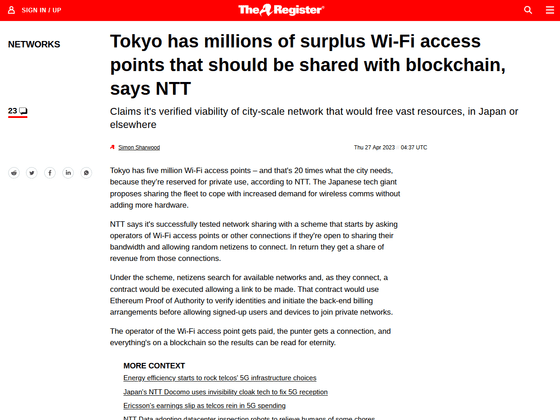NTT has developed wireless access sharing technology using blockchain, which can respond to the increasing demand for wireless communication while reducing equipment costs and power consumption

Succeeded in the world's first demonstration experiment of wireless access sharing technology using blockchain-Contributing to the realization of ICT resource sharing among individuals leading to reduction of equipment costs and power consumption in society as a whole- | News Releases | NTT
https://group.ntt/jp/newsrelease/2023/04/26/230426a.html

Surplus Wi-Fi Access points should be shared, says NTT • The Register

According to NTT, by 2030, wireless traffic is expected to increase approximately 80 times compared to 2020. In addition to further upgrading wireless access, securing wireless resources to process all wireless traffic is essential. considered urgent. One way to secure wireless resources is to significantly increase the number of wireless base stations, etc., but increasing the number of facilities to handle all wireless traffic poses the problem of soaring costs.
If it is possible to effectively use wireless resources such as wireless LANs and local 5G owned by individuals and companies, it will be possible to secure wireless resources while keeping costs down. There are an estimated 5 million wireless LAN access points in operation in Tokyo, and about 20 times as many access points as the required wireless traffic have already been installed. If surplus access points can be shared with others, it will be possible to respond to the expected increase in wireless traffic in the future with minimal wireless equipment and power consumption.
However, conventional methods of sharing wireless access pose problems such as reduced security and usage efficiency, and deterioration of communication quality.

Therefore, NTT conducted a demonstration experiment to solve the problems that existed in wireless access sharing technology by using blockchain.
With NTT's blockchain-based wireless access sharing technology, the user's device first attaches a list of nearby wireless base stations that have observed wireless signals such as Wi-Fi and their own
After that, by verifying the digital signature on the blockchain network, we confirm the identity and confirm that there is no fraud such as tampering with the requested content. In addition, it considers the congestion status of each base station from the list of surrounding wireless base stations sent by the personal device and determines the appropriate connection destination.
The operator of the access point, that is, the side that shares the wireless access that it owns, will be able to receive rewards from the users of the service.

In a demonstration experiment conducted by NTT, three wireless base stations and 10 devices with different administrators were prepared, and by using wireless access sharing technology using blockchain, wireless access for various administrators was possible. Even in a mixed environment, it is confirmed that each device can contract and use wireless access on a case-by-case basis.
In addition, we have solved the problem of devices concentrating on wireless access points with excellent communication quality by using NTT's proprietary wireless resource utilization improvement technology. By referring to the communication contract history on the blockchain network using this wireless resource utilization improvement technology, the number of devices connected to each wireless base station and congestion status can be grasped. By controlling the communication charges so that the more congested wireless base stations are, the higher the communication charges are, and the less congested wireless base stations are, the lower the communication charges, the concentration of people at some wireless access points is suppressed. increase. The state of the demonstration experiment conducted by NTT is as follows. By using technology to improve the utilization efficiency of wireless resources, it is possible to equalize the number of devices connected to wireless base stations in a decentralized and autonomous manner.

It is said that the use of this radio resource utilization improvement technology will eventually eliminate congestion and improve the radio resource utilization efficiency of the entire radio access. Below is a graph showing '

Looking ahead, NTT will need to increase the number of Wi-Fi access points and mobile base stations if it is possible to scale up its wireless access sharing technology and wireless resource usage efficiency improvement technology, even if the demand for wireless connections surges. is expected to disappear. We also speculate that by enabling network expansion without increasing energy consumption, frequency bands that have been used so far will be able to be used for other purposes.
Furthermore, even if wireless access is interrupted during a disaster, by applying these technologies, it will be possible to seamlessly switch to other wireless access, and it is expected to provide a network that will not be interrupted even in the event of a disaster. NTT said, 'We will promote further studies toward the establishment of the technology in fiscal 2024, with the aim of realizing new shared radio access in the future through incentives for radio access providers.'
On the other hand, the overseas news media The Register said, ``We need to deal with various objections regarding security, such as the dangers of using public networks. It is difficult to resolve,' he said.
Related Posts:
in Smartphone, Posted by log1r_ut







